We’ve already reviewed a $50 Raspberry Pi 5 with just 2GB of RAM; now we move to the other end of the scale and we have the new $120 Raspberry Pi 5 16GB model in for review.
You may have just glanced over the price, so let's make this clear. Yes, this is a Raspberry Pi 5 with 16GB of RAM for $120 (£115). That is $40 more than the 8GB model. There is no other difference between the models. We get the same CPU and we can use the same peripherals and accessories. So is the Raspberry Pi 5 16GB worth the extra money? Does the extra RAM improve the overall performance? Let’s find out.
Raspberry Pi 5 Hardware Specifications
Swipe to scroll horizontally
| SoC | BCM2712 SoC Arm Cortex-A76 64-bit CPU running at 2.4 GHz |
| Row 1 - Cell 0 | 800 MHz VideoCore VII GPU, supporting OpenGL ES 3.1, Vulkan 1.2 |
| Display | 2 x 4Kp60 HDMI display output with HDR support |
| RAM | 1,2,4,8,16GB LPDDR4X-4267 SDRAM |
| Storage | Micro SD (SDR104 compatible) M.2 NVMe SSD via M.2 HAT |
| GPIO | 40 Pin Raspberry Pi HAT Compatible |
| USB | 2 x USB 2 2 x USB 3 (simultaneous 5Gbps) |
| Connectors | 2 × 4-lane MIPI camera/display transceivers PCIe 2.0 x1 interface UART breakout RTC clock power Fan power |
| Networking | Gigabit Ethernet, PoE via PoE+ HAT |
| Wi-Fi / Bluetooth | Dual-band 802.11ac, Bluetooth 5 / BLE |
| Power Button | Soft power button |
| Power | 5V 4A via USB C PoE via Poe+ HAT 5V via GPIO |
| Dimensions | 85 x 56mm |
| MSRP | 1GB TBC 2GB $50 4GB $60 8GB $80 16GB $120 |
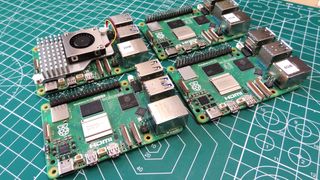
The Raspberry Pi 5 16GB is exactly the same as previous models of Pi 5. The same accessories and cases will work, and you can still overclock the CPU to get a free boost of speed. The only difference, from a user perspective, between the Raspberry Pi 5’s is the amount of RAM. In fact, you can spot the difference between lower specced Raspberry Pi 5s quite easily. Raspberry Pi has chosen to highlight the fact in the silkscreen. The “table” previously used to identify the RAM is gone, but the resistor used to identify is still present.

Under the hood though, the Raspberry Pi 5 16GB uses the same, lower-cost, D0 stepping as the Raspberry Pi 5 2GB, and this means that the 2 and 16GB models have more in common than the earlier models. The D0 stepping (BCM2712D0) removed “all the non-Raspberry Pi specific logic from the chip” according to Raspberry Pi co-founder Eben Upton, while leaving it functionally identical to the previous.
To really see what the difference is, you would need to de-lid the chip, something that Jeff Geerling did for the 2GB model. The “dark silicon” is essentially the unused part of the chip, and the removal of non-Raspberry Pi specific logic means that there is a 33% reduction in die space. What was taken out? On the Raspberry Pi 2GB it was the Ethernet and USB logic, with both features being moved to the RP1 “Southbridge” chip.
Can I use my favorite add-ons?
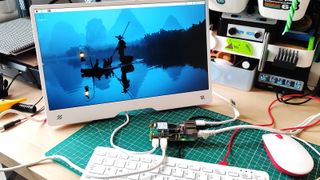
If you have already invested in Raspberry Pi 5 AI HATs, NVMe storage, cases and cooling, then you can easily use them with the Raspberry Pi 5 16GB. The GPIO pinout, port locations and chip locations are all the same, and compatible with your add-ons. I tested Pineboards' HatDrive! Nano and everything was good.
What Applications / Projects Would Benefit From 16GB?
More RAM is always better. Your machine has more space to swap data with the CPU, and you can run more applications, or heavier applications without bottlenecks. A 16GB Raspberry Pi 5, with its quad-core 2.4GHz CPU means that we have a true Raspberry Pi desktop. Throw in an NVMe drive and perhaps a little overclock, and your Raspberry Pi 5 16GB would be a viable desktop alternative.
Raspberry Pi has released a slew of AI based products in 2024, and the extra RAM could also be a benefit to AI-intensive projects.
Test 1: Boot Times
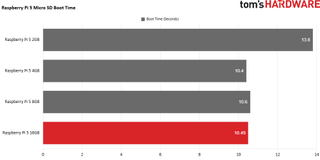
Boot times were recorded using the very latest Raspberry Pi OS release on a 32GB Raspberry Pi-branded A2 / SDR104 micro SD card. This means that we are giving each of the four Raspberry Pi 5’s that we tested the best chance of recording a fast boot, without the need for an NVMe drive.
The long and short of it is that the 4, 8 and 16GB models of Raspberry Pi 5 all booted in around 10.5 seconds. Interestingly, the 2GB model took 13.8 seconds to boot. All of these times are faster than the 20 second boot time we recorded when we last tested, showing that the new micro SD cards, and general OS improvements are creating faster and more responsive Raspberry Pi OS experience.
If you want a faster boot time, and vastly improved overall performance, invest in an NVMe drive and HAT. You can buy the official Raspberry Pi M.2 HAT+, but our current favorite is the $9 Pineboards HatDrive! Nano, to which we awarded the Tom's Hardware Editor's Choice award.
Test 2: OS RAM Use
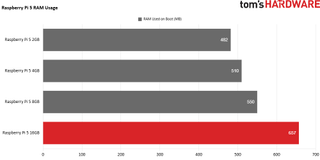
Does more RAM mean that the OS will gobble up any spare Megabytes? Well yes, it does. Starting with the 2GB model, which saw 482MB used after boot, the 4GB model used a little more RAM on boot, using 510MB after settling down. The 8GB model used 550MB, a little more RAM again. But the 16GB model saw a whopping 657MB used on boot, 107MB more than the 8GB Pi 5. But with 16GB of RAM you’re not going to notice the OS nibbling a little more RAM to keep it sated.
Test 3: Web Browsers
There is no escaping web browsers. They are our portal to another realm, and we use multiple browsers every single day. For those of us blessed with long memories of the Raspberry Pi, we remember the old days when opening a browser took forever. But now thanks to more RAM, better CPUs and lots of clever coding, the Raspberry Pi is a much better platform for web browsing or for getting some work done.
Newer Raspberry Pi OS releases have given us the choice of two browsers. Chromium or Firefox. Both of these browsers run well, even on the Raspberry Pi 5 2GB. It really just boils down to your personal preference.
Swipe to scroll horizontally
| Chromium Launch in Seconds | 5.83 | 4.16 | 3.6 | 6.03 |
| Firefox Launch in Seconds | 7.6 | 11.13 | 9.7 | 11.9 |
Launch times for both browsers were a little mixed. For Chromium, the Raspberry Pi 5 8GB launched the fastest at 3.6 seconds, then 4GB (4.16), 2GB (5.83) and finally 16GB at 6.03 seconds. Yeah, the Raspberry Pi 16GB was the slowest to start Chromium.
For Firefox, the Raspberry Pi 5 2GB was the fastest at 7.6 seconds. Next was the 8GB at 9.7, the 4GB at 11.13, and finally (again) the 16GB at 11.9 seconds.
Honestly, don’t read too much into this; once the browser is loaded, you won’t notice the difference. Unless you start opening a lot of tabs, and that leads us nicely on to our browser tab torture test.
The test is automated using Python, which opens 5,10,40 and finally 50 browser windows, then it tells us how much RAM the process is using.
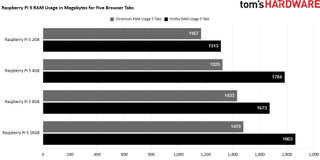
We start with a measly five browser tabs for both browsers. With Chroumium, it was the 2GB Raspberry Pi 5 that used the least amount of RAM. Just 1167MB (57% of its total RAM). Next was the Pi 5 4GB, 1325MB (32%), 8GB, 1433MB (17.5%) and finally the 16GB, 1479MB (9%). The keen eyed will have noticed that for each version, there was an increase in the amount of RAM used. Some were large, like the 158MB jump from a Pi 5 2GB to 4GB, but the difference between the 16GB and 8GB Pi 5 usage was a measly 46MB.
Swipe to scroll horizontally
| Raspberry Pi 5 2GB | 1167 | 56.98 | 1313 | 64.11 |
| Raspberry Pi 5 4GB | 1325 | 32.35 | 1784 | 43.55 |
| Raspberry Pi 5 8GB | 1433 | 17.49 | 1673 | 20.42 |
| Raspberry Pi 5 16GB | 1479 | 9.03 | 1863 | 11.37 |
Repeating the same process in Firefox, and we can see that it uses more RAM than Chromium and there is a quirk where the Raspberry Pi 5 4GB uses more RAM than the 8GB and 16GB models, so the progression is not linear. Firefox on a Pi 5 2GB uses 1313MB (64.1%) of the RAM. On a 4GB model it uses 1784MB (43%). A Pi 5 8GB running five tabs in Firefox used 1673MB (20.4%) and a 16GB model used 1863MB (11.3%).
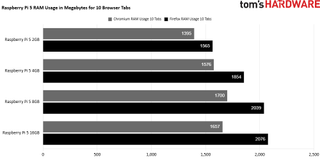
Moving on to ten browser tabs and we can see the increase in RAM usage as we move up the 2,4,8,16. But another quirk sees Chromium RAM usage for ten tabs on an 8GB Pi 5 being slightly higher than the 16GB model.
Swipe to scroll horizontally
| Raspberry Pi 5 2GB | 1395 | 68.12 | 1565 | 76.42 |
| Raspberry Pi 5 4GB | 1576 | 38.48 | 1854 | 45.26 |
| Raspberry Pi 5 8GB | 1700 | 20.75 | 2039 | 24.89 |
| Raspberry Pi 5 16GB | 1657 | 10.11 | 2076 | 12.67 |
Firefox was a linear progression whereas the available RAM was increased, Firefox ate a little more RAM. But as we go up the scale, the percentage of RAM consumed is not so much of a big deal.
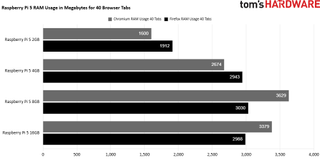
Now we reach the point where things get interesting / embarrassing for the Raspberry Pi 5 2GB. You see, we have just enough RAM to open 40 tabs in Chromium, (1600MB) but Firefox consumed 1912MB and caused the system to hang. This time both browsers had a “quirk” which saw the Raspberry Pi 5 8GB use more RAM than the 16GB model.
Swipe to scroll horizontally
| Raspberry Pi 5 2GB | 1600 | 78.13 | 1912 | 93.36 |
| Raspberry Pi 5 4GB | 2674 | 65.28 | 2943 | 71.85 |
| Raspberry Pi 5 8GB | 3629 | 44.3 | 3030 | 36.99 |
| Raspberry Pi 5 16GB | 3379 | 20.62 | 2988 | 18.24 |
The final browser torture test sees 50 tabs open at once and the Raspberry Pi 5 2GB unsurprisingly failed to open all of the tabs in Firefox, crashing once again after consuming 1945MB of RAM (95.17%). But, Chromium actually worked and “only” used 1705MB (83.25%).
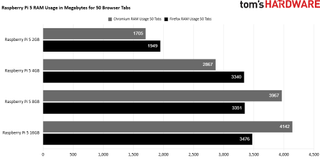
Yes, the Raspberry Pi 5 2GB failed with Firefox, but it put up one hell of a battle! It crashed, in glorious style! The 4,8 and 16GB models all followed a linear path where more available RAM meant the browser had more to eat.
Swipe to scroll horizontally
| Raspberry Pi 5 2GB | 1705 | 83.25 | 1949 | 95.17 |
| Raspberry Pi 5 4GB | 2867 | 70 | 3340 | 81.54 |
| Raspberry Pi 5 8GB | 3967 | 48.43 | 3351 | 40.91 |
| Raspberry Pi 5 16GB | 4142 | 25.28 | 3476 | 21.22 |
| Row 4 - Cell 0 | Row 4 - Cell 1 | Row 4 - Cell 2 | Row 4 - Cell 3 | Row 4 - Cell 4 |
I’ll admit, opening 50 browser tabs is absurd, but it shows that the range of Raspberry Pi 5’s, even the lowest spec, can be used for browser based applications. The “quirks” that I encountered can be explained by the dynamic nature of web pages. Behind the scenes there are multiple JavaScript scripts running, images and content such as advertisements can skew the returned results.
The sweet spot for price versus performance is still the 4GB, leaving the 16GB model reserved for “power users.”
The final browser test is where we run Browserbench Speedometer 3.0, a JavaScript performance tool which measures how many test runs it can complete per minute. The more in a minute, the better.
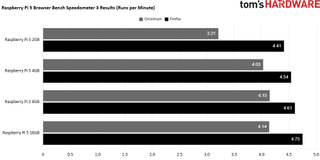
The worst performance came from the Raspberry Pi 5 2GB running in Chromium, managing 3.21 runs per minute (RPM). The Raspberry Pi 8 and 16GB were pretty close. The 4GB managed 4.15 RPM in Chromium, and 4.61 RPM in Firefox. The 8GB hit 4.14 RPM in Chromium and 4.75RPM in Firefox. So, more RAM doesn’t necessarily mean a huge leap in performance for browser based tasks.
Swipe to scroll horizontally
| Raspberry Pi 5 2GB | 3.21 | 4.41 |
| Raspberry Pi 5 4GB | 4.03 | 4.54 |
| Raspberry Pi 5 8GB | 4.15 | 4.61 |
| Raspberry Pi 5 16GB | 4.14 | 4.75 |
Test 4: File Compression
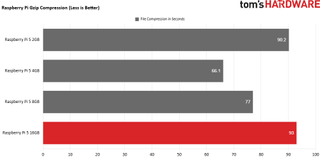
Does more RAM provide better performance when compressing an archive? It turns out that in our tests, no it does not. Oddly the Raspberry Pi 5 4GB returned the fastest time, 66.1 seconds. The 16GB returned the worst time, 93 seconds.
The test is a simple compression of a single Gamecube ISO image that was saved to the Raspberry Pi branded 32GB A2 micro SD card. The command that we ran was
gzip -k name_of_file.isoThe 27 second difference between the 4 and 16GB models is huge, and slap bang in the middle lies the 8GB Pi 5 at 77 seconds, 16 seconds faster than the 16GB model.
Test 5: High-End Emulation

Faster and more powerful Raspberry Pi’s means that we can emulate more recent “retro” machines and just like in previous Raspberry Pi 5 emulation tests, I break out the Dolphin emulator. Dolphin can emulate the Nintendo Gamecube and Wii and I used it to play a level of Metroid Prime. The test involved running the emulator, and loading the game disc. I would then wait until the title screen appeared with the “Press Start” prompt. I then recorded the RAM usage from another terminal which was using the watch command to update the free -m command every two seconds.
The results are pretty unexciting (unlike Metroid Prime which is still awesome 23 years later). Yes the Raspberry Pi 5 16GB used a little more RAM (51MB more than the 8GB) but at no time did the RAM usage provide any worries, even for the 2GB Pi 5. GameCube emulation is hitting the limits of what any Raspberry Pi 5 can provide; older consoles are much easier to emulate. Sony PlayStation 1, Sega Dreamcast and Nintendo 64 are the current highest sweet spot where many of the games “just work.”
Who is the Raspberry Pi 5 16GB for?
I can see this being used by those of us who want to take the Raspberry Pi 5 to the extreme. Overclocking, AI, machine learning, Home Assistant and automation will be a lot smoother with 16GB, as will using containers like Docker which can be stressful on system resources. It can also be used as a desktop replacement machine, but the $120 price tag puts it squarely in the jaws of a slew of Intel N100 machines which offer better performance, and can run any OS. Take the LattePanda Mu and the Radxa X4 which both use the Intel N100 CPU. The LattePanda Mu has just been upgraded to an Intel Core i3-N305 CPU which is claimed to be three times more powerful than the Raspberry Pi 5, and it also comes with 16GB of RAM.
Conclusion
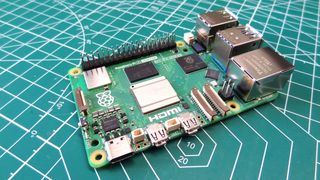
For $120 you do get a lot more RAM, but is it worth the extra $40 over an 8GB model? For most of us, probably not. This is the extreme Raspberry Pi 5 for those who must be on the bleeding edge, those who crave the ultimate and need all of the performance that they can muster.
I still stand by my statement that the Raspberry Pi 5 4GB is the sweet spot. All that power, for not too much money. If you are planning on using a Raspberry Pi 5 as a desktop computer then get as much RAM as you can afford. For electronics, GPIO and “the usual” Raspberry Pi projects, the 16GB Raspberry Pi 5 is overkill, especially at this price.

 12 hours ago
8
12 hours ago
8
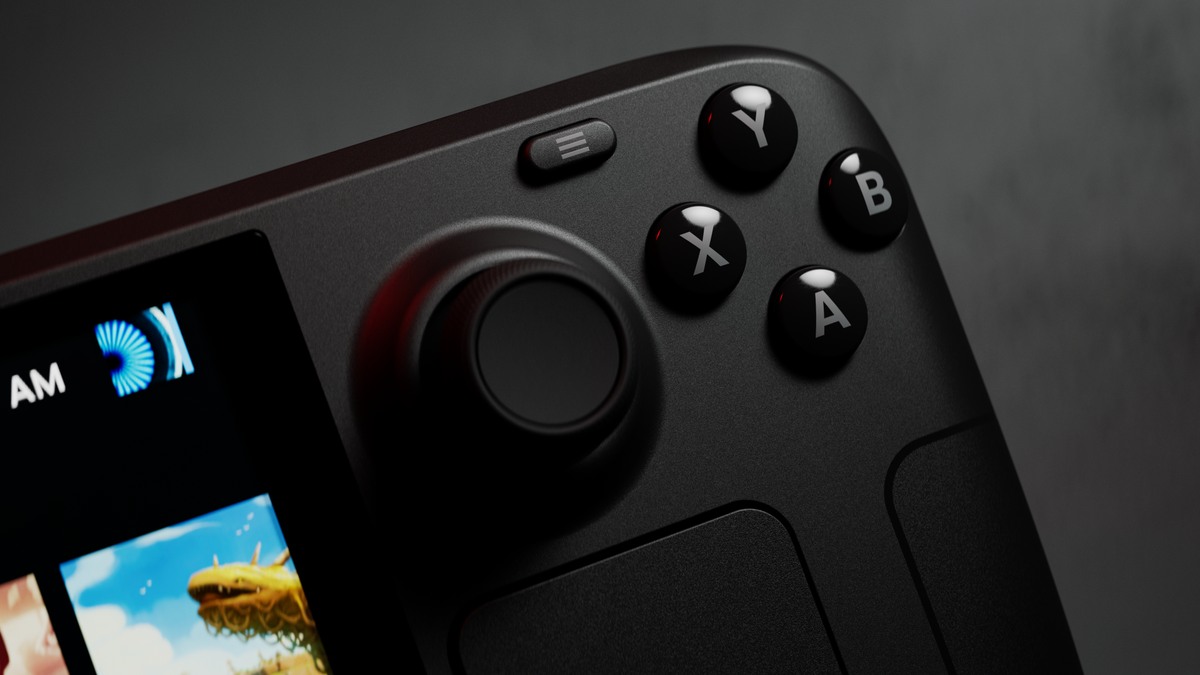

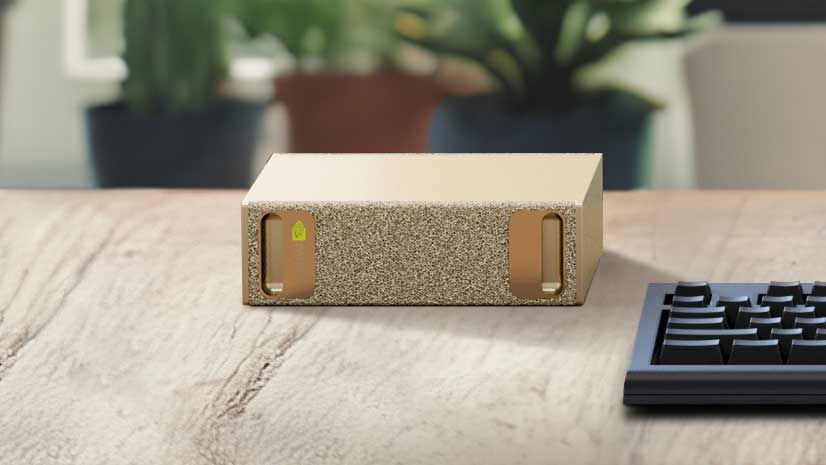





 English (US) ·
English (US) ·